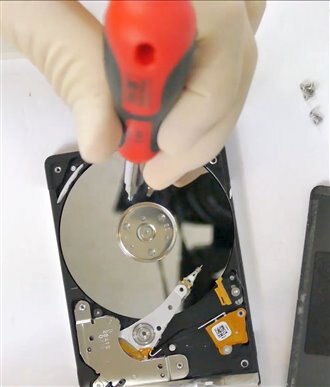A few months ago I purchased a 2.5" 2 TB USB hard disk drive mostly for backup, but I started using it for project work that had lots of video in it. A few days ago it wouldn't power up with my computer - it just made an intermittent beeping sound. After some research I decided this was probably a situation where the heads got stuck to the disk. I haven't seen any complete analysis of why or how heads get stuck to disks, but here is my speculation: Heads normally stay in their parked position beside the disk until the disk is up to speed. When the heads launch onto the surface the boundary layer of air at the disk surface, travelling with the disk, forces the heads to fly a few nanometers above the surface using something like wing-in-ground-effect. To counteract the lift force the heads must be pushing down due to a weak spring, because they can operate on their side. If the disk stops spinning while the heads are above its surface, the heads will contact the surface, because the lift force of the air disappears. There is about 1 nm of lubricant on the disk surface, which allows a perfect air-tight seal of the head to the surface, so air pressure clamps the head to the disk just like a suction cup. On a small disk like the one I have this air pressure creates enough friction to prevent the small motor from spinning the disk. There must be some smarts in the disk that senses an overload and intermittently tries to restart, hence the beeping sound.
Hopefully the heads got stuck just as the disk stopped rotating and didn't scratch a groove in the disk. The following video shows my attempt to dismantle the disk drive and un-stick the heads. I'm not recommending anyone else should or shouldn't do this, it is just a story of what I did.
This procedure worked perfectly for me. The disk fired right up and I immediately copied all files to another disk - about 1 TB of data.
I do not expect to use this disk again, but I will keep it around as the data on it represents some sort of last resort extra backup for the files that are already on it.
I did have one totally unexpected thing happen. After I copied all the files off the disk to another external hard drive and was shutting the system down, the computer went through its normal shutdown process and turned off. However, both the recovered drive and the new drive continued to spin. Both drives are powered via USB but these USB ports do not have power when the computer is off, so it is a mystery where the power was coming from to keep the drives spinning. I let them spin for a couple of minutes to see if they would shut off before yanking both USB cables. Of course this was quite worrisome as it could have caused another head crash on both drives. They definitely shut off when the cables were pulled. That is a new one for me.....anyone out there ever see something like that?
I also had never heard of stuck heads before this happened, but after researching the possible failure modes based on the symptoms, and watching some Youtube on the subject, I decided it was worth trying to fix myself. Although it isn't actually a fix, it is just a recovery process. I do not have a statistically valid sample to make a guess at the likelihood of success or failure because I have only tried it once and it worked 100% as a recovery process.


Top Comments
-

Gough Lui
-
Cancel
-
Vote Up
+5
Vote Down
-
-
Sign in to reply
-
More
-
Cancel
-

dougw
in reply to Gough Lui
-
Cancel
-
Vote Up
+3
Vote Down
-
-
Sign in to reply
-
More
-
Cancel
-

Gough Lui
in reply to dougw
-
Cancel
-
Vote Up
+2
Vote Down
-
-
Sign in to reply
-
More
-
Cancel
Comment-

Gough Lui
in reply to dougw
-
Cancel
-
Vote Up
+2
Vote Down
-
-
Sign in to reply
-
More
-
Cancel
Children